People
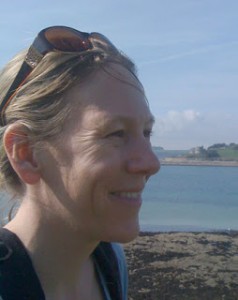 Laura Robinson:As chief scientist for the cruise I will be responsible for coordinating where we go and what we do. I will be supported by an excellent team from all over the world. Between us we will work together to collect the samples that we need for the project. I have been working on putting together this cruise for several years now, so it is very exciting to see it all coming together.
Laura Robinson:As chief scientist for the cruise I will be responsible for coordinating where we go and what we do. I will be supported by an excellent team from all over the world. Between us we will work together to collect the samples that we need for the project. I have been working on putting together this cruise for several years now, so it is very exciting to see it all coming together.
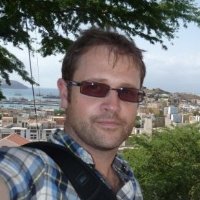 Paul Morris: I am a postdoctoral researcher from the University of Bristol and I will be sampling deep-sea corals to investigate how climate changed as the Earth exited the last ice-age between 17,000-10,000 years ago. The fossilised remains of corals alive during this time preserve a record in their skeletons of what the conditions were like in the deep-ocean. I use naturally present isotopes of uranium and thorium trapped within the coral skeleton to determine when the corals were alive and then tie these ages with other geochemical markers that tell us about parameters such as temperature, dissolved nutrients and oxygen, and carbonate chemistry. On the cruise I will lead one of the 12 hour shifts, working closely with the Chief Scientist, the ship-board science support staff and the science team to ensure we fulfil our science goals. I will also be responsible for running the dissolved oxygen titration system, which will allow us to precisely determine the concentration of oxygen in the deep-ocean, a factor known to play a critical role in the distribution of deep-sea corals alive today. You can follow me on twitter @OceanObserver.
Paul Morris: I am a postdoctoral researcher from the University of Bristol and I will be sampling deep-sea corals to investigate how climate changed as the Earth exited the last ice-age between 17,000-10,000 years ago. The fossilised remains of corals alive during this time preserve a record in their skeletons of what the conditions were like in the deep-ocean. I use naturally present isotopes of uranium and thorium trapped within the coral skeleton to determine when the corals were alive and then tie these ages with other geochemical markers that tell us about parameters such as temperature, dissolved nutrients and oxygen, and carbonate chemistry. On the cruise I will lead one of the 12 hour shifts, working closely with the Chief Scientist, the ship-board science support staff and the science team to ensure we fulfil our science goals. I will also be responsible for running the dissolved oxygen titration system, which will allow us to precisely determine the concentration of oxygen in the deep-ocean, a factor known to play a critical role in the distribution of deep-sea corals alive today. You can follow me on twitter @OceanObserver.
 Allison Jacobel: I am currently a graduate student at Columbia University where I am involved in research designed to further our understanding of the transition between cold (glacial) and warm (interglacial) climates. To accomplish this, I use geochemical techniques to examine paleoclimate records like the sediment cores we’ll be collecting on this cruise. On the RSS James Cook, I’ll help to determine the age of the sediments we retrieve from the seafloor by examining the skeletons of microorganisms preserved therein. Once we’re back on land I’ll measure the carbon and oxygen isotopic composition of a subset of those organisms. This information helps us determine paleo temperature, salinity, ice volume and nutrient concentrations and also helps create a higher-resolution chronology for our sediment cores. All of these elements are important because they help us sharpen the picture of what environmental conditions were like in the equatorial Atlantic Ocean hundreds, thousands and hundreds of thousands of years ago.
Allison Jacobel: I am currently a graduate student at Columbia University where I am involved in research designed to further our understanding of the transition between cold (glacial) and warm (interglacial) climates. To accomplish this, I use geochemical techniques to examine paleoclimate records like the sediment cores we’ll be collecting on this cruise. On the RSS James Cook, I’ll help to determine the age of the sediments we retrieve from the seafloor by examining the skeletons of microorganisms preserved therein. Once we’re back on land I’ll measure the carbon and oxygen isotopic composition of a subset of those organisms. This information helps us determine paleo temperature, salinity, ice volume and nutrient concentrations and also helps create a higher-resolution chronology for our sediment cores. All of these elements are important because they help us sharpen the picture of what environmental conditions were like in the equatorial Atlantic Ocean hundreds, thousands and hundreds of thousands of years ago.
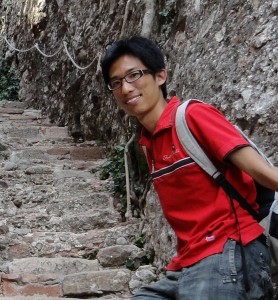
Hong Chin Ng: Ocean circulation has played an important role in driving past climate changes. These large-scale events left behind various evidences that could be preserved in ocean sediments. My work is to “decipher” some of these evidences to provide a better understanding of past ocean-climate interaction. I mainly focus on the proxies of past ocean circulation rate: Protactinium-2 31/Thorium-230 isotope ratios, radiocarbon (C-14) and size of sortable silt (2-64 micrometer). In the TROPICS cruise you will usually see me processing sediment cores that will be collected from ocean depths of hundreds to thousands of meters, treating seawater samples in the lab, or looking at microfossil foraminifera which store wealth of information of past ocean and climate condition in their tiny cute shells.
 Jesse van der Grient : I am a second year PhD student working on benthic macrofauna, with a special focus on polychaetes. I am using the data to study different macro-ecological patterns. I am looking at the structuring of diversity, ecosystem functioning and body size on different spatial scales, how these factors relate to each other, and what the role of the environment is in shaping the relationships between them. I am very excited to be on this cruise, my very first one. It will allow me to get a better understanding of how the sampling process works and see the organisms I work with first hand. Furthermore, it is absolutely amazing to be able to work with and learn from the scientists in other research fields present here on board.
Jesse van der Grient : I am a second year PhD student working on benthic macrofauna, with a special focus on polychaetes. I am using the data to study different macro-ecological patterns. I am looking at the structuring of diversity, ecosystem functioning and body size on different spatial scales, how these factors relate to each other, and what the role of the environment is in shaping the relationships between them. I am very excited to be on this cruise, my very first one. It will allow me to get a better understanding of how the sampling process works and see the organisms I work with first hand. Furthermore, it is absolutely amazing to be able to work with and learn from the scientists in other research fields present here on board.
 Kais Mohamed Falcon: I´m a marine scientist interested in just what lies under the sea. Most of the ocean floor is covered in sediments (sometimes several km thick!). These sediments are composed of material coming from the continents, skeletons of microorganisms, submarine volcanic emissions, dust, etc. Like in a book, the layers of the sediments will tell us the story of the world the moment they were deposited. In particular, we will try to reconstruct how ocean circulation and structure has changed since the last glacial maximum (the last Ice Age), and how that is related to climate changes. My research tries to obtain this information by analysing the characteristics of these sediments, their chemical composition and the way they interact and respond to magnetic fields produced in the lab. My role during the TROPICS cruise will be to coordinate the scientific coring activities, which will include obtaining the uppermost part of the sediment deposits as well as long tubes filled with sediments, which we call cores, by using gravity-, piston- and mega-coring devices. Stay tuned to the cruise blog to learn more about these activities when we are at sea!
Kais Mohamed Falcon: I´m a marine scientist interested in just what lies under the sea. Most of the ocean floor is covered in sediments (sometimes several km thick!). These sediments are composed of material coming from the continents, skeletons of microorganisms, submarine volcanic emissions, dust, etc. Like in a book, the layers of the sediments will tell us the story of the world the moment they were deposited. In particular, we will try to reconstruct how ocean circulation and structure has changed since the last glacial maximum (the last Ice Age), and how that is related to climate changes. My research tries to obtain this information by analysing the characteristics of these sediments, their chemical composition and the way they interact and respond to magnetic fields produced in the lab. My role during the TROPICS cruise will be to coordinate the scientific coring activities, which will include obtaining the uppermost part of the sediment deposits as well as long tubes filled with sediments, which we call cores, by using gravity-, piston- and mega-coring devices. Stay tuned to the cruise blog to learn more about these activities when we are at sea!
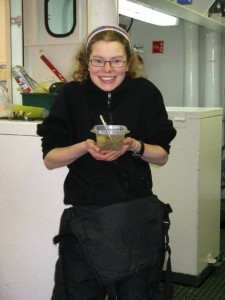 Kate Hendry: I’m a geochemist and oceanographer, and my research is geared towards understanding the behaviour of silicon, which is an important – but lesser known – nutrient in seawater. I’m on the cruise to collect samples of organisms that use silicon to make their skeletons, such as deep-sea sponges, which are simple animals that live on the seafloor. I’ll also be taking seawater samples to measure for nutrients, including dissolved silicon, and other tracers of biological activity.
Kate Hendry: I’m a geochemist and oceanographer, and my research is geared towards understanding the behaviour of silicon, which is an important – but lesser known – nutrient in seawater. I’m on the cruise to collect samples of organisms that use silicon to make their skeletons, such as deep-sea sponges, which are simple animals that live on the seafloor. I’ll also be taking seawater samples to measure for nutrients, including dissolved silicon, and other tracers of biological activity.
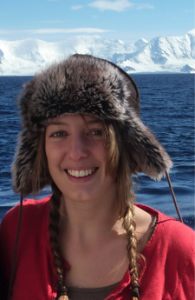
Leigh Marsh: I am currently in the final year of my PhD at the University of Southampton, based at the National Oceanography Centre, Southampton. Working in the colder climes of the Antarctic, my work focuses on the use of ROV technology to examine life at hydrothermal vents and how the fauna associated with these remote habitats change in both space and time. Using high-definition ROV videography, I have recreated life-size images of hydrothermal chimneys, which are used to look at patterns of zonation, biological interactions and raise awareness of these generally inaccessible environments of the deep ocean. During the Tropics cruise I will be assisting team science in collecting ROV data, including the hours of HD video footage we will acquire. I am also looking forward to improving my deep-sea coral identification skills! I graduated from the University of Southampton in 2005 with a Masters in Oceanography and have worked for UK governing bodies and commercial survey companies as a marine conservation officer and marine ecologist. I returned to the University of Southampton to start my PhD in 2009 and hopes to complete my studies later this year.
 Lucy Woodall: I am a marine biologist with interests in an array of topics from population genetics to conservation. I currently work at the Natural History Museum, and am delighted to join Laura and her team aboard the James Cook. During the transect of the Atlantic I will be collecting benthic sediment and surface water, to assess the human impact on the ocean. This analysis will include isolating and identifying the meiofauna (all the very small animals, <1mm); for examples of nematodes please see pictures in the Lab page of this website. In addition I will be collecting, identifying and preserving other large fauna, which will be sent off to collaborating expert taxonomists.
Lucy Woodall: I am a marine biologist with interests in an array of topics from population genetics to conservation. I currently work at the Natural History Museum, and am delighted to join Laura and her team aboard the James Cook. During the transect of the Atlantic I will be collecting benthic sediment and surface water, to assess the human impact on the ocean. This analysis will include isolating and identifying the meiofauna (all the very small animals, <1mm); for examples of nematodes please see pictures in the Lab page of this website. In addition I will be collecting, identifying and preserving other large fauna, which will be sent off to collaborating expert taxonomists.
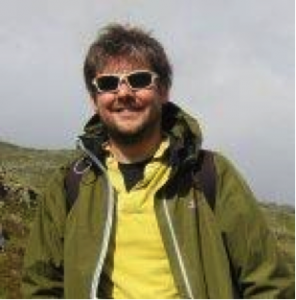 Marcus Badger: I study ancient climates using molecular fossils. When an organism dies, often components of the organic remains are preserved in sediments. By analysing molecules characteristic of particular organisms or environmental conditions (“biomarkers”) we can reconstruct ancient environmental parameters. My research primarily uses organic geochemical proxies analysed by GC, GC-MS, LC-MS and GC-C-IRMS to reconstruct sea surface temperatures (TEX86 and UK’37) and atmospheric pCO2 (alkenone δ13C) along with other key indicators of past climates. I follow a multi-proxy approach and so also utilise more ‘traditional’ inorganic proxies, based on the skeletal remains, such as planktonic foraminiferal Mg/Ca, δ13C and δ18O, generating these records either myself or with collaborators. My research has previously involved using organic biomarker proxies in the Cenozoic, working on periods of time 2.6 to 56 Million years ago, so the TROPICS cruise is the first time I’m working directly on such recent material. I hope to use the biomarker proxies I’m familiar with to investigate ocean-atmosphere interaction during the deglacial, and to study how organisms produce biomarkers today. My role on the cruise is to manage the carbonate chemistry sampling, and to assist in coring. I also just love being at sea – so when I was offered the chance to join the James Cook I jumped at it!
Marcus Badger: I study ancient climates using molecular fossils. When an organism dies, often components of the organic remains are preserved in sediments. By analysing molecules characteristic of particular organisms or environmental conditions (“biomarkers”) we can reconstruct ancient environmental parameters. My research primarily uses organic geochemical proxies analysed by GC, GC-MS, LC-MS and GC-C-IRMS to reconstruct sea surface temperatures (TEX86 and UK’37) and atmospheric pCO2 (alkenone δ13C) along with other key indicators of past climates. I follow a multi-proxy approach and so also utilise more ‘traditional’ inorganic proxies, based on the skeletal remains, such as planktonic foraminiferal Mg/Ca, δ13C and δ18O, generating these records either myself or with collaborators. My research has previously involved using organic biomarker proxies in the Cenozoic, working on periods of time 2.6 to 56 Million years ago, so the TROPICS cruise is the first time I’m working directly on such recent material. I hope to use the biomarker proxies I’m familiar with to investigate ocean-atmosphere interaction during the deglacial, and to study how organisms produce biomarkers today. My role on the cruise is to manage the carbonate chemistry sampling, and to assist in coring. I also just love being at sea – so when I was offered the chance to join the James Cook I jumped at it!
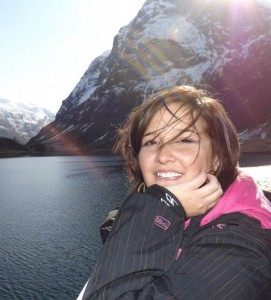 Maricel Williams: My current research in the University of Bristol examines the effects of climate change and ocean acidification on the calcification of marine plankton throughout the last 30,000 years through observations of preserved plankton shells in marine sediment cores in the sub-polar North Atlantic. I am also analysing geochemical data to determine past changes in marine sediment transport as a result of changes in ocean circulation. My role on the cruise will be to assist in coring and to analyse plankton microfossils preserved in marine sediments. I will be using planktic foraminifera as a biostratigraphic tool for relative dating of marine sediment cores. The abundance and diversity of diatom species preserved in the sediments can also provide valuable information on past sea surface environments. I am optimistic that my knowledge of Antarctic diatoms studied during my Masters year will prove useful on the TROPICS cruise in the identification of some equatorial species!
Maricel Williams: My current research in the University of Bristol examines the effects of climate change and ocean acidification on the calcification of marine plankton throughout the last 30,000 years through observations of preserved plankton shells in marine sediment cores in the sub-polar North Atlantic. I am also analysing geochemical data to determine past changes in marine sediment transport as a result of changes in ocean circulation. My role on the cruise will be to assist in coring and to analyse plankton microfossils preserved in marine sediments. I will be using planktic foraminifera as a biostratigraphic tool for relative dating of marine sediment cores. The abundance and diversity of diatom species preserved in the sediments can also provide valuable information on past sea surface environments. I am optimistic that my knowledge of Antarctic diatoms studied during my Masters year will prove useful on the TROPICS cruise in the identification of some equatorial species!
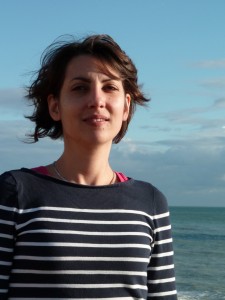 Melanie Dourain: I am a post-doctoral researcher based at the University of Nantes. My research is currently focusing on using cold-water corals geochemistry for palaeo-environmental reconstructions, and reconstructing coral palaeo-biogeography. My interest for cold-water corals started with my Masters project on their geochemisty, microstrutures and biomineralisation processes. During my PhD I have worked on reconstructing the growth history of a shallow cold-water coral reefs from offshore Scotland. I am therefore very enthusiastic to join the scientific team onboard the James Cook to help out and to discover exciting coral sites down south, sampling techniques and obviously different coral ecosystem compared to those I have been working on.
Melanie Dourain: I am a post-doctoral researcher based at the University of Nantes. My research is currently focusing on using cold-water corals geochemistry for palaeo-environmental reconstructions, and reconstructing coral palaeo-biogeography. My interest for cold-water corals started with my Masters project on their geochemisty, microstrutures and biomineralisation processes. During my PhD I have worked on reconstructing the growth history of a shallow cold-water coral reefs from offshore Scotland. I am therefore very enthusiastic to join the scientific team onboard the James Cook to help out and to discover exciting coral sites down south, sampling techniques and obviously different coral ecosystem compared to those I have been working on.
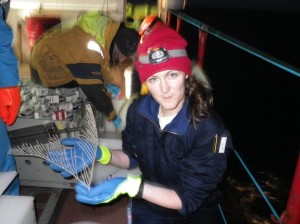
Michelle Taylor: My current research is focused on the benthic ecosystems found on seamounts. I’m specifically interested in connectivity of deep-sea fauna, their evolution, and speciation. So far my work has focused on deep-sea corals; which was a natural progression from my years spent studying shallow water coral reefs.Genetics are my tool of choice for targeting questions about evolution and speciation. My work involves phylogenetics and population genetics, which is often complimented by taxonomy. Deep-sea coral reefs, as their shallow water counterparts, are habitats for an extraordinary variety of organisms: squat lobsters, brittlestars, worms and amphipods are often found in abundance on and around reef structures and coral gardens. I hope to collect examples of benthic animals to investigate cross-ridge population genetic connectivity as well as deep-sea coral for taxonomic and phylogenetic studies. I specialise in octocorals and as they are a particularly understudied habitat it is common to find new species… something we can cross our fingers for on this voyage.
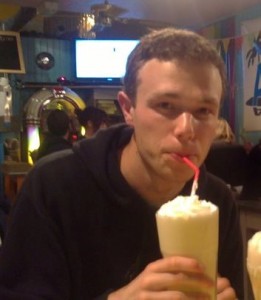 Peter Spooner: I am a PhD student interested in cold-water corals, and what they can tell us about the oceans of the past. Coral skeletons can record some properties of the seawater that they grow in, including temperature and pH. By dissolving the skeletons and measuring tiny amounts of Magnesium (Mg) and Lithium (Li) contained within them, we can try and use corals as thermometers for working out how ocean temperature has changed through time. I am hoping to collect a large number of coral skeletons from the seafloor using the ROV Isis. These samples will help me to improve the precision of the (Mg/Li) thermometer so that we can begin to make useful estimates of how deep ocean temperature has been affected by past climate changes.
Peter Spooner: I am a PhD student interested in cold-water corals, and what they can tell us about the oceans of the past. Coral skeletons can record some properties of the seawater that they grow in, including temperature and pH. By dissolving the skeletons and measuring tiny amounts of Magnesium (Mg) and Lithium (Li) contained within them, we can try and use corals as thermometers for working out how ocean temperature has changed through time. I am hoping to collect a large number of coral skeletons from the seafloor using the ROV Isis. These samples will help me to improve the precision of the (Mg/Li) thermometer so that we can begin to make useful estimates of how deep ocean temperature has been affected by past climate changes.
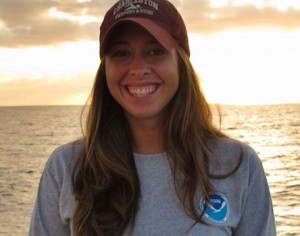 Shannon Hoy: I am an ocean scientist with a wide array of experience ranging from marine biology, geology and seafloor mapping. Specifically for this cruise I will be one part of a two person team acquiring and processing sounding data, which we can use to create maps of the seafloor. The ship sends sound to the seafloor and then listens for the return echo. By knowing the speed of sound in water and the time it took for the sound to travel round trip we can calculate the depth of the seafloor. Since the ship’s echosounder can send out multiple pings of sound at the same time, we can measure a coverage of the seafloor of up to 3 times the water depth in a matter of seconds. That is up to 9000 meters in deeper areas of the ocean! Knowing what the seafloor looks like is very important for understanding the biology found on the seafloor as well as aiding in operations of ship instruments like ROVs and coring mechanisms.
Shannon Hoy: I am an ocean scientist with a wide array of experience ranging from marine biology, geology and seafloor mapping. Specifically for this cruise I will be one part of a two person team acquiring and processing sounding data, which we can use to create maps of the seafloor. The ship sends sound to the seafloor and then listens for the return echo. By knowing the speed of sound in water and the time it took for the sound to travel round trip we can calculate the depth of the seafloor. Since the ship’s echosounder can send out multiple pings of sound at the same time, we can measure a coverage of the seafloor of up to 3 times the water depth in a matter of seconds. That is up to 9000 meters in deeper areas of the ocean! Knowing what the seafloor looks like is very important for understanding the biology found on the seafloor as well as aiding in operations of ship instruments like ROVs and coring mechanisms.
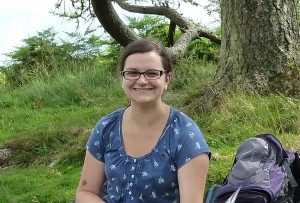 Stephanie Bates: I am a PhD student at the School of Earth and Ocean Sciences in Cardiff University. My work involves using foraminifera, a type of single-celled organism, to study past oceanic conditions. The chemistry of ocean water is recorded in the calcium carbonate shells of foraminifera, so by measuring the content of these shells we can investigate what the oceans were like back through time. During my PhD I will be investigating the use of Ba/Ca ratios in foraminiferal calcium carbonate as a proxy for seawater alkalinity. Before coming to Cardiff University I studied Environmental Geoscience at the University of Bristol.
Stephanie Bates: I am a PhD student at the School of Earth and Ocean Sciences in Cardiff University. My work involves using foraminifera, a type of single-celled organism, to study past oceanic conditions. The chemistry of ocean water is recorded in the calcium carbonate shells of foraminifera, so by measuring the content of these shells we can investigate what the oceans were like back through time. During my PhD I will be investigating the use of Ba/Ca ratios in foraminiferal calcium carbonate as a proxy for seawater alkalinity. Before coming to Cardiff University I studied Environmental Geoscience at the University of Bristol.
 Torben Struve: I am a PhD student based at Imperial College London and my project is focused on the geochemical properties of fossil cold-water corals. Such corals precipitate their skeletons from ambient seawater and thus, incorporate a chemical fingerprint of contemporaneous seawater into their skeletons. In order to learn about past water mass mixing and nutrient cycling in the water column I measure the isotopic composition of neodymium (Nd) and cadmium (Cd) extracted from the aragonitic skeletons of scleractinian cold-water corals. In combination with U-Th dating, radiocarbon analyses, temperature and pH reconstructions fossil cold-water coral skeletons are a powerful archive to unravel past ocean properties.
Torben Struve: I am a PhD student based at Imperial College London and my project is focused on the geochemical properties of fossil cold-water corals. Such corals precipitate their skeletons from ambient seawater and thus, incorporate a chemical fingerprint of contemporaneous seawater into their skeletons. In order to learn about past water mass mixing and nutrient cycling in the water column I measure the isotopic composition of neodymium (Nd) and cadmium (Cd) extracted from the aragonitic skeletons of scleractinian cold-water corals. In combination with U-Th dating, radiocarbon analyses, temperature and pH reconstructions fossil cold-water coral skeletons are a powerful archive to unravel past ocean properties.
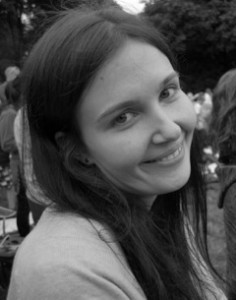 Vanessa Fairbank: Having studied chemistry for my undergraduate degree I’m the token chemist on board. This is my first cruise and I’m excited (and a little bit scared?!) about going to sea for 7 weeks. My project involves using the stable isotope fractionation of Mg, Ca and Sr during the formation of marine, and inorganically precipitated carbonates, to investigate how these elements are incorporated into carbonate materials. During the cruise I’ll be part of “team water”, helping to collect and sample seawater. I’ll also be collecting as many different forms of calcium carbonate as we can find.
Vanessa Fairbank: Having studied chemistry for my undergraduate degree I’m the token chemist on board. This is my first cruise and I’m excited (and a little bit scared?!) about going to sea for 7 weeks. My project involves using the stable isotope fractionation of Mg, Ca and Sr during the formation of marine, and inorganically precipitated carbonates, to investigate how these elements are incorporated into carbonate materials. During the cruise I’ll be part of “team water”, helping to collect and sample seawater. I’ll also be collecting as many different forms of calcium carbonate as we can find.
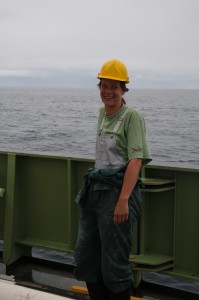
Veerle Huvenne: I am a Marine Geoscientist from the NOC (National Oceanography Centre in Southampton), specialised in deep-sea habitat mapping, especially of complex environments such as submarine canyons, cold-water coral reefs and hydrothermal vent fields. To achieve this, I often work with underwater vehicles such as ROVs (Remotely Operated Vehicles) and AUVs (Autonomous Underwater Vehicles). On this expedition, I will be working with Shannon Hoy to coordinate and carry out all mapping activities. We will use the ship-borne multibeam echosounder to create detailed bathymetric maps of the seamounts and ROV dive sites. Combined with information derived from the video recordings, this will allow the science team to get a good idea of the spatial distribution of benthic communities and seabed features. In addition, the maps will form the basis for ROV dive planning and the identification of sampling sites.